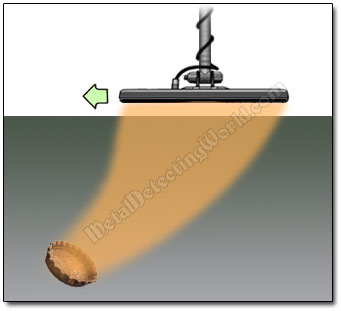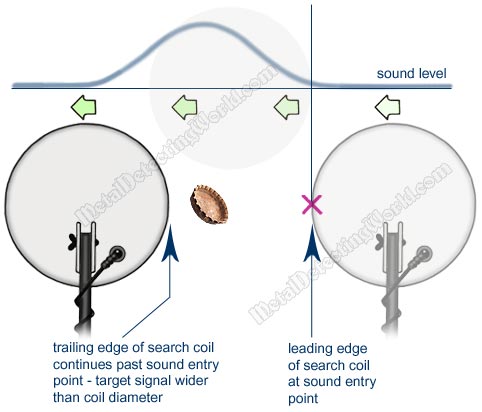Search Coils for Metal Detectors, page 19
Metal Detecting Techniques and Methods: Questionable Target Identification Techniques
(...CONTINUED from previous page)
In the motion discriminate mode, both expensive and inexpensive metal detectors produce seemingly good responses to larger, heavily rusted ferrous targets which contain conductive and nonconductive properties. Sometimes an operator of an inexpensive metal detector can use Discrimination as ID function.
This can be simply done by turning the Discrimination knob (if it is utilized) clockwise to increase the Discrimination level, while scanning an unknown target, and see if the target still responds. However, even when Discrimination is set up at high levels, the motion discriminate mode can not ignore large iron objects sometimes.
In this case, you should switch to the all-metal non-motion mode - Pinpoint mode, to identify a ferrous target. Iron bearing objects distort the electromagnetic field, and we can use this effect to our advantage when making a decision whether to dig.
For example, as you approach a moderately sized ferrous bearing target, such as a rusted steel bottle cap, the audio signal in the non-motion all-metal mode will begin sounding before the leading edge of the search coil passes over the edge of the target.
Distortion of Electromagnetic Field by Ferrous Object

When encountering a questionable target, remove the search coil away from the target area to a distance at least the diameter of the coil or more. Operating your detector in All-Metal mode, slowly approach the target area again.
As the target audio appears, notice where the leading edge of the coil is in relation to the ground. Mark the spot with your toe if necessary (make sure your boot toes do not contain metallic plates to cause false signals!).
Determining Width of Ferrous Signal

With the coil still traveling toward the target, keep your eyes fixed on the initial sound entry point. If the trailing edge of the search coil goes beyond this point, and the target audio continues and eventually fades, the audio signal width is considered wider than the diameter of the search coil. The target is most likely ferrous in composition.
Large nonferrous targets such as aluminum cans can produce wide audio signals, but the width of those signals will not be wider than the search coil diameter. In other words, the signal will end as the trailing edge of the coil passes the initial sound entry point for nonferrous targets.
Deeply buried coins will not produce much sound width at all. Some thoroughly rusted square nails may escape this technique, but this method will generally save a lot of unnecessary digging on most targets. Using this technique as a way to outline signal boundaries provides for more accurate and nondestructive recoveries at the manicured lawns.
This technique is very helpful for relic hunting. If you are using a motion Discriminate search mode to reject nails, this technique can quickly verify the larger, equally desirable ferrous targets. Such targets could be pistols, gun barrels, cannon balls, battle axes and sword blades.
"Pendulum Swing" is another effective method for identification of questionable targets. When you encounter such a target, keep your detector in a motion discriminate mode and start swinging the search coil as fast as you can in a pendulum motion, with the lowest point over the target area. If the partial signal of high tone disappears, it is likely to be a ferrous target.
This simple technique may work or may not with any metal detector. Find a few singular questionable targets in the field, try this technique, and see if it works with your machine. I have successfully used this method with my Tesoro Cortes which has an elliptical concentric search coil. But I have not used this method with my Minelab E-Trac utilizing a Double-D search coil because this machine offers other effective means for identification of questionable targets (you may want to read my article "Questionable Signals and How To Decipher Them").
In addition, there are situations when a positive target response disappears after the recovery process begins. This "fanthom signal" may be caused by either 1) inaccurate pinpointing or 2) a reaction of the detector's Discriminate circuit to the target's "Halo Effect".